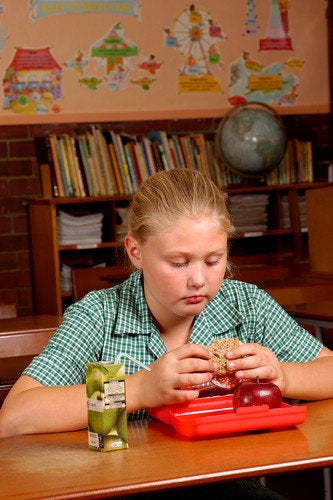
The first time you hand a child an apple instead of a cookie, or a baked sweet potato wedge instead of a French fry, he is bound to be disappointed. Similarly, the first time you give a child a math textbook, he may come home frustrated with fractions. But we don't give up on our kids with math, and we shouldn't give up on them with healthy food. We simply can't afford to.
Americans now spend an estimated $190 billion on healthcare costs associated with obesity and diet-related disease. Two weeks ago, Mission: Readiness, an organization led by retired senior military leaders, released its new report, "Still Too Fat to Fight." The publication documents the national security risk of having one in four of our young people be unfit (literally) for military service. The stakes around healthier school lunches are much higher than apples thrown in the trash.
Every child deserves a lunch that is healthy, that tastes good, and that he or she is eager to eat. But these preferences aren't just inborn; they're shaped by the environment in which our children are raised. The typical elementary student receives 3.4 hours of nutrition education in a year of schooling. When those same kids go home, they watch an average of ten food-related ads each day, nearly all of them promoting products that are high in fat, sugar or sodium.
The reality is that if we want kids to be excited to find something healthier than fast food in their school cafeteria, we have to do more than change what's on the lunch tray.
Merely swapping out kid favorites like chicken fingers and French fries for healthier calories isn't enough. To help children develop a positive attitude toward healthy food, we need to think more like marketers. We need to engage kids in growing a tomato, chopping peppers for salsa, and learning to try new foods and love them (even the green ones). Working with farmers, chefs, teachers, parents and professionals on the lunch line, we need to address the entire school food environment, and transform the cafeteria into a place where healthy choices aren't just served, but celebrated, too.
The nationwide team of leaders affiliated with our national service organization, FoodCorps, has seen first-hand the difference this approach makes. Every week we are inundated with stories like Rachel's, from Arkansas: "After a salad tasting, one of my students told me that he used to think Sonic made the best food in town, but now he says that garden food is the best." Or Robyn, from Michigan, who reported that she knows she's "making an impact when a student voraciously eats green beans at the end of the lesson, when he insisted he would never touch one at the beginning." Parents in in Mississippi report that their kids come home and ask for the vegetables they tried that day at school.
Last week the American Journal of Medicine chose FoodCorps as the winner of their Childhood Obesity Challenge, a competition that sought innovative solutions to the crisis of diet-related disease. They, like other leaders in this conversation, recognize that simply changing the calories on the lunch tray isn't enough.
There's a lot we can do to continue improving what we serve our kids in school. But giving them access to healthy, tasty food will only be part of the real solution. If we care about growing a healthy generation of kids, we have to look longer-term than the first few weeks of the new school lunch guidelines, and we have to take a broader view than just what's on the tray. Because learning Lunch, like learning Math, takes patience.
Debra Eschmeyer is a co-founder of FoodCorps, a national service organization that promotes healthy eating and nutrition education at schools in 12 states.